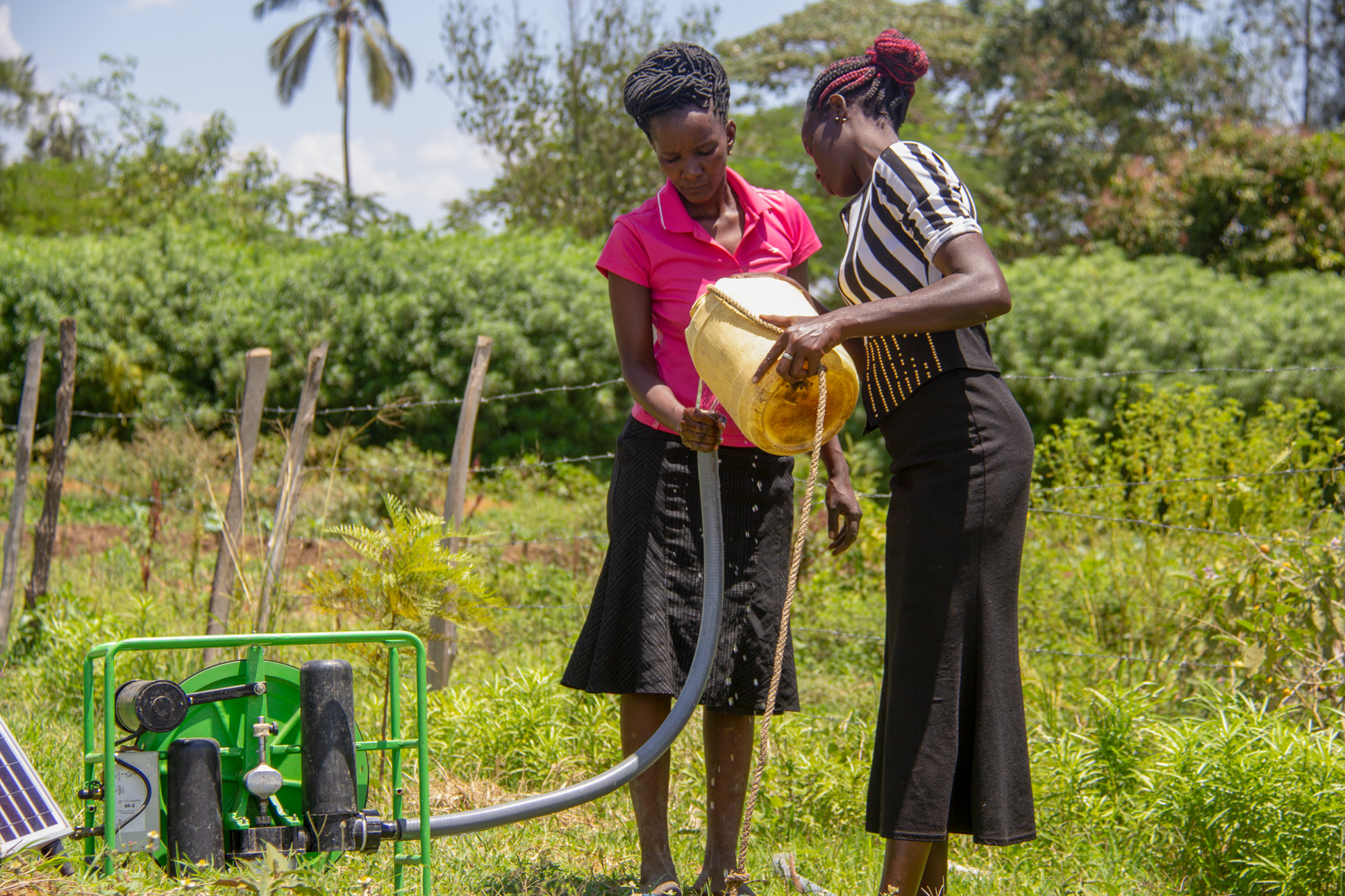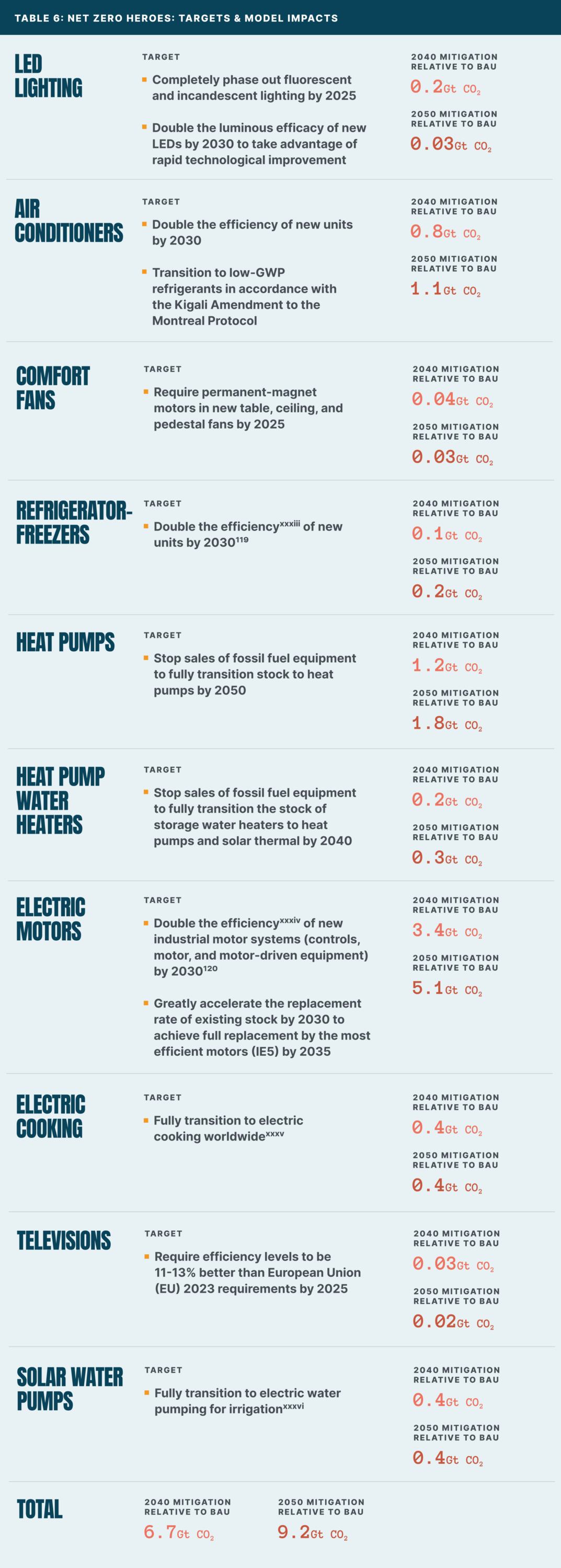03 Net Zero Heroes: Efficient Appliances
Inefficient appliances and large appliance access gaps severely hinder efforts to lower emissions and build climate resilience. Sections 1 and 2 of this report highlight the urgent need to radically reduce the negative impacts of inefficient appliances while simultaneously expanding the positive impacts from more efficient appliances to everyone.
Efficient appliances are a climate solution that uniquely sits at the nexus of climate mitigation and adaptation. Efficient appliances lower final energy demand and resulting emissions in a cost-effective manner and can expand access through lower operating costs. Unfortunately, appliance efficiency is often ignored in favor of other mitigation solutions, and therefore has not been utilized to its full potential. As a result, appliance emissions are expected to exceed what is needed to achieve NZE in 2050 by 9 Gt CO2.
This section presents a series of ambitious efficiency targets that would put appliances on a pathway to NZE by 2050 and help close critical appliance access gaps.

CLASP advocates for urgent climate action focused on ten “Net Zero Heroes”—the appliances essential for reducing GHG emissions and building climate resilience globally.
These ten appliances are: 1
- LED lighting
- Air conditioners
- Comfort fans
- Refrigerator-freezers
- Heat pump space heating
- Heat pump water heaters
- Industrial motors
- Electric cooking
- Televisions
- Solar water pumps
Appliances currently account for roughly 40% of all energy-related CO2 emissions. Promoting the Net Zero Heroes by achieving the targets set forth in this section would deliver significant CO2 reductions by 2050.
Achieving the efficiency targets for all ten Net Zero Heroes would avoid 9.2 Gt of CO2 in 2050 relative to BAU.
Achieving CLASP’s Net Zero Hero targets would also improve the quality of life for millions of people by helping households and communities stay comfortable and connected during emergencies and natural disasters, reap the health and wellness benefits of enhanced food security, unlock opportunities for income generation, and foster more equitable outcomes for marginalized groups.
Meeting Net Zero Hero appliance efficiency targets would expand access to critical appliances to hundreds of millions of people while reducing exposure to climate risks through improved access to cooling technologies, enhanced food and water security, and new income-generating activities.
Achieving the efficiency targets for all ten Net Zero Heroes would avoid 9.2 Gt of CO2 in 2050 relative to BAU.
This section is divided into two parts. Part one introduces the ten Net Zero Heroes, presents targets for each, and forecasts climate mitigation impacts of meeting those targets. Part two quantifies the additional adaptation, resilience, and sustainable development benefits of meeting the efficiency targets shared in part one.
3.1 Mitigation Potential
Achieving the CO2 emissions reductions necessary to reach NZE by 2050 and limit global warming to 1.5 °C will require ambitious appliance policies and regulations, implemented promptly, and revised frequently.
As discussed in Section 2.1, new, ambitious efficiency policies are necessary to reduce appliance electricity consumption and make room within the renewable electricity budget for the electrification of fossil-fueled end uses, providing access and resilience, and accommodating future population and economic growth. BAU, and even some of the best policies in play today, are insufficient to stay within the emissions budget and achieve net zero.
CLASP calls for a concerted effort and renewed focus on ten energy end-uses—the Net Zero Heroes. The energy efficiency of these Net Zero Heroes must be greatly increased this decade. Table 5 identifies a specific energy efficiency target for each end-use that, if met, will allow appliances to remain within the budgets for both energy and emissions, resulting in significant CO2 reductions compared to today’s best policies.2
Table 6: Net Zero Heroes: Targets & Model Impacts

In Figure 16 below, we graph the energy for the appliances analyzed in Mepsy under the Net Zero Hero scenario as well as the Global Benchmarks and BAU scenarios, analyzed earlier. While the energy consumption starts out the same across all scenarios in 2021, the energy in the Net Zero Hero Policies scenario starts diverging after 2030 and stays within 25% of the budget based on the IEA Net Zero Emissions by 2050 scenario. In contrast, the energy consumption continues to climb in the BAU and Global Benchmarks scenarios.
While this energy consumption does exceed the budgets, we assumed that the excess could be further mitigated through behavioral change or additional efficiency improvements (discussed below) such that the eventual energy consumption would fall within the budget. For example, IEA expects behavior change to be a large share of the transition to NZE, contributing about half as much in the transition off of methane gas as efficiency does.3
Figure 16: Electricity & Fuel Consumption Under BAU, Global Benchmarks & Net Zero Hero Scenarios
In contrast, because of continuing high energy demand under the BAU and Global Benchmarks scenarios, a significant portion of the demand cannot be met by renewables or mitigated through other means, resulting in continued indirect emissions past 2040.4 As a result, Figure 17 shows the size of these emissions along with those from any unelectrified fossil fuels. It is clear that we can only reach NZE if we increase ambition beyond even some of the most ambitious policies adopted today.
Figure 17: CO2 Emissions Under BAU, Global Benchmarks & Net Zero Heroes Scenarios
Only the Net Zero Heroes program outlined in Table 6, characterized by a doubling of the efficiency of some products and urgent electrification of others, can sufficiently drive down energy use and emissions. Further ambition beyond what we have seen to date will be needed to achieve this agenda, both in terms of the frequency and stringency of policy updates and the use of complementary policies, including those that yield behavioral changes and building envelope improvements.
First, it will be important for countries to revise policies frequently to cement efficiency gains and continue taking advantage of technological improvement. Once an efficiency policy is adopted, manufacturers have to redesign some of their products to meet it. When these new products enter the market, policymakers should reevaluate whether further gains are possible. For example, in one country that CLASP recently analyzed, all the air conditioners on the market are twice as efficient as the minimum standard, meaning that the standard is not serving its function and should be revised. Another country revises its air-conditioner policies every two to four years to keep up with market efficiency improvements, but is nevertheless behind the world’s best MEPS levels.5 In other words, frequent updates must be paired with ambition to meet net zero targets.
CLASP has modeled a series of such revisions in a country with a fast-growing economy, and found that it would be possible to meet a 50% energy reduction (an efficiency doubling) for new AC, refrigerators, industrial motor systems, and lighting by 2030. This would be consistent with the country’s commitments under the Product Efficiency Call to Action (see Section 2.1), as well as contribute to achieving NZE by 2050. Efficiency policies would be revised every two to five years, leveraging resources such as U4E model regulations and IEA’s policy ladders6 to maintain pace and ambition. The policies noted above would result in CO2 mitigation once the stock turns over. However, to start reducing CO2 emissions before 2030, the doubling efficiency and decarbonization policies would have to be complemented by additional policies and programs such as:
- Incremental efficiency requirements prior to 2030 (e.g., 25% reduction in energy in 2025);
- Incentives for early replacement (especially for long-lived products such as heating and air conditioning, and commercial and industrial equipment such as motors);
- Programs targeting other components of the system (e.g., efficiency gains from incremental improvements in motor efficiency are relatively small; much larger gains can be achieved by using variable speed drives and more efficient end-use components, such as pumps, compressors, and fans, as well as by digitization);
- Labeling or purchasing guidelines that encourage even higher efficiencies for a subset of customers, which can help drive investment into higher efficiency and pave the way for subsequent standards revisions.
Section 4 summarizes a range of policy options available to governments, donors, and other market actors to both improve the efficiency of appliances and promote the production and sale of more efficient models.
3.2 Adaptation, Resilience & Development Potential
Yet another reason to make appliance efficiency a priority now is that people urgently need access to appliances and the resilience and adaptation benefits they deliver. One sure way to make appliances accessible to more people is to make them more affordable. Improving efficiency is an effective way to drive down lifecycle costs, making appliances more affordable. Later in this section, we will present evidence that this mechanism works and estimate what impact improved efficiency could have on affordability and access.

Energy Efficiency Drives Appliance Access
Climate mitigation potential is reason enough to focus on improving the efficiency of appliances, but improved efficiency can also lead to greater climate resilience and adaptation by improving affordability and, thereby, bringing appliances within reach of more people.
Energy efficiency catalyzes access to appliances by lowering running costs as well as first costs. The evidence connecting increased efficiency with improved affordability is compelling. It is well established that more efficient appliances cost less to operate due to their lower electricity or fuel consumption. This is a central tenet of most appliance standards programs, which are designed to reduce energy consumption and save consumers money on their utility bills (see Section 4).
Increased efficiency not only reduces energy costs; it can also drive down the total cost of ownership (TCO), i.e., first cost plus operating cost. A comparison of the estimated incremental prices of appliance standards in the US found that these costs were routinely overestimated. When developing standards for nine products,7 the US government predicted a manufacturer selling price increase of $148 USD; the actual average was a decrease in price by $9 USD.8 A similar analysis found that product prices often decrease over time, even as efficiency improves. For example, the average (quality-adjusted) price of a new refrigerator in 2015 was actually 35% lower than it was in 1987, despite large improvements in efficiency.9 Similar price trends have been reported for the same period for clothes washers (45% lower) and dishwashers (30% lower).10
A 2018 study sought to determine the optimal levels of energy conservation (efficiency) standards for refrigerators and freezers in Uganda. The researchers calculated the TCO of baseline units and more efficient units and found that standards could reduce the TCO by $173 USD for freezers, $35 USD for refrigerators, and $21 USD for refrigerator-freezers. The researchers concluded that implementing standards and making refrigeration products more affordable in Uganda, where the average household spends 22% of its annual income on energy, would help to expand access to these appliances.11
This same dynamic is also at play in off-grid contexts, where the energy system must be sized to meet the requirements of the connected appliances. Efficiency for Access compared the costs of purchasing and operating efficient and inefficient solar-powered refrigerator-freezers using price data collected between 2017 and 2019. When considering the purchase price of the appliance, together with the solar energy system needed to power it, they found that the efficient refrigerator-freezers were between $300 USD and $900 USD less expensive than inefficient models, depending on the size of the food compartment and other features.12 Even though the energy-efficient solar refrigerator-freezers are more affordable than inefficient models, they remain out of reach for many low-income families. Additional interventions, such as the consumer financing options discussed in section 4.3, are needed to ensure that all families can access refrigerator-freezers. Nevertheless, energy efficiency remains a necessary ingredient in expanding access to refrigeration to off-grid populations.
Enabling a Just Energy Transition
Achieving the efficiency targets in Section 3.1 (see Table 6) for the Net Zero Heroes is not only critical for climate mitigation, but it will also yield huge benefits for the health and wellbeing of people all over the world. We identified some of the other benefits (beyond climate mitigation), including climate resilience, adaptation, health, environmental, economic, and human development benefits, that would accrue from reaching the Net Zero Heroes Targets. These other benefits are described briefly below and summarized in Table 7.
Air conditioners and refrigerator-freezers: Doubling the efficiency of new units by 2030 would make these important cooling appliances more affordable. We adapted SEforALL’s analysis and estimated that these efficiency improvements would make air conditioners accessible to 123 million more people and refrigerators accessible to 262 million more people. In addition, these efficiency improvements would enable millions of consumers to save money on their electricity bills. For more detail, see our Spotlight on Cooling Appliances.
Electric cookers and solar water pumps: We quantified the adaptation, resilience and other human development benefits from expanding access to solar water pumps and enabling universal access to electric cooking. Details are provided in the Spotlight on Electric Cooking on the Spotlight on Solar Water Pumps.
LED lighting, space heating, water heating, and cooking: A full transition to LED lighting would eliminate toxic mercury pollution from the production, breakage, and disposal of fluorescent lighting. A transition from fossil fuel-powered equipment to heat pumps for space heating and water heating and to electric cooking appliances would eliminate methane leakage from these end uses and reduce air pollution. See our Spotlight on Air Pollution for more on how appliance efficiency can help to reduce air pollution levels and improve human health.
Electric motors: Improved electric motor efficiency in industry is associated with increases in industrial competitiveness and productivity and with improved quality control.13
LED lighting, comfort fans, and televisions: As with air conditioners and refrigerators, a sustained focus on improving the availability of good-quality, energy-efficient, and affordable LED lighting, comfort fans, and televisions will also serve to increase access to these three Net Zero Heroes. It would also allow consumers to save money on their electricity bills, an especially important benefit for low-income households.
In Section 3.1, we identified an efficiency target for each Net Zero Hero and quantified the climate mitigation potential for each. In Table 6 we show the same targets again and summarize some of the other benefits of meeting these targets.
Table 7: Net Zero Heroes: Targets & Other Benefits

To support those most affected by climate change and end energy poverty, CLASP advocates for an expanded definition of energy access that includes ten essential appliances critical to building resilience. To date, most efforts to build climate resilience within the energy sector have focused on expanding access to the 2.9 billion people that lack access to clean cooking solutions, and the 675 million people that lack access to electricity.14 Expanding the focus of the existing energy access agenda from new connections and kWh to include access to appliances and equipment would unlock the development impacts of expanded power supply. At the same time, the energy efficiency community must broaden its priorities from climate mitigation and avoided CO2 emissions to include appliance access and climate adaptation and resilience.
Jump to the next section, Taking Proven Solutions to Scale.
For a full list of references and endnotes, please download the report PDF.
0. CLASP’s ten Net Zero Heroes differ from the ten climate appliances essential to building climate resilience in Sections 1 and 2. The Net Zero Heroes are the ten appliances most critical to reducing the energy demand GHG emissions needed to achieve NZE by 2050. However, many Net Zero Heroes are also critical climate resilience and adaptation benefits, particularly for households gaining access to these products for the first time.
1. As some of the Net Zero Hero targets do not begin until 2030, the modeled impacts include today’s best policies as a stepping stone between 2030 and 2050.
2. IEA, “World Energy Outlook 2022,” 123.
3. We assume that any energy consumption beyond that in the Net Zero Heroes cannot be met with renewables. The IEA’s Net Zero Roadmap requires renewable energy capacity to triple by 2030. This is an ambitious target. Annual capacity additions have risen an average of 11% between 2015 and 2020.
4. P. V. N. Kishore Kumar et al., “Policy Measures and Impact on the Market for the Room Air Conditioners in India,” in Energy Efficiency in Domestic Appliances and Lighting, ed. Paolo Bertoldi, Springer Proceedings in Energy (Cham: Springer International Publishing, 2022), 95–108, https://doi.org/10.1007/978-3-030-79124-7_8.
5. Clean Energy Ministerial, “Industrial Electric Motor Systems,” https://www.cleanenergyministerial.org/, accessed May 10, 2023, https://www.cleanenergyministerial.org/efficient_products/industrial-electric-motor-systems/.
6. The nine products standards included: refrigerators, clothes washers (2x), electric water heaters, non-electric water heaters, central ACs (3 tons), room ACs, commercial ACs (15 tons), and ballasts.
7. Steven Nadal and Andrew deLaski, “Appliance Standards: Comparing Predicted and Observed Prices” (Washington, DC: ACEEE, 2013), https://www.aceee.org/research-report/e13d.
8. Joanna Mauer et al., “Better Appliances: An Analysis of Performance, Features, And Price as Efficiency Has Improved” (Washington, DC and Boston, MA: American Council for an Energy-Efficient Economy and Appliance Standards Awareness Project, 2013), 16, https://appliance-standards.org/document/better-appliances-analysis-performance-features-and-price-efficiency-has-improved.
9. Mauer et al., 28, 39.
10. Stephane de la Rue du Can, David Pudleiner, and Katrina Pielli, “Energy Efficiency as a Means to Expand Energy Access: A Uganda Roadmap,” Energy Policy 120 (September 1, 2018): 354–64, https://doi.org/10.1016/j.enpol.2018.05.045.
11. Efficiency for Access, “Appliance Data Trends Report, 2021,” 2021, https://efficiencyforaccess.org/publications/2021-appliance-data-trends.
12. A. De Almeida et al., “New Technology Trends and Policy Needs in Energy Efficient Motor Systems – A Major Opportunity for Energy and Carbon Savings,” Renewable and Sustainable Energy Reviews 115 (November 1, 2019): 109384, https://doi.org/10.1016/j.rser.2019.109384.
13. IEA et al., “Tracking SDG 7: The Energy Progress Report 2022,” 2022, https://trackingsdg7.esmap.org/data/files/download-documents/sdg7-report2022-full_report.pdf.